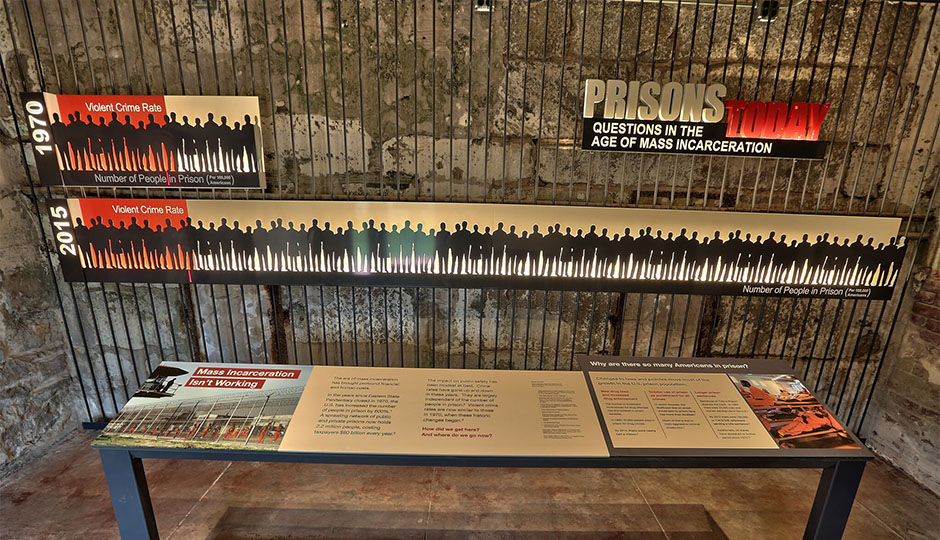New Eastern State Exhibit Explores Mass Incarceration

Courtesy of Eastern State Penitentiary
Next to a window overlooking an eerie courtyard at the Eastern State Penitentiary, there is a wall lined with sheets of paper revealing statements of crimes by imprisoned and non-imprisoned individuals.
The confessions seem indistinguishable from one another.
“You’d see visitors staring at the confessions, trying to guess which was which, realizing that they might have been considered a criminal had things gone just a little bit different at some point in their life,” says Sean Kelley, Eastern State’s senior vice president and director of interpretation and public programming.
The display is part of the penitentiary’s latest exhibit, “Prisons Today: Questions in the Age of Mass Incarceration,” which explores the political and social effects of the criminal justice system in the United States since the middle of the 20th century. In a era when the country has the highest rate of incarceration in the world (with just 5 percent of world population, the U.S. holds 25 percent of the world’s inmates,) Eastern State is bringing contemporary issues into its museum of prison history, illuminating the realities of jails far different from Al Capone’s elegant cell.
The concept for “Prisons Today” started brewing around the 2013 premiere of The Big Graph, a mammoth structure in the middle of the courtyard that tracks prison population growth since 1900. “We thought we needed something that would show what the prison system looks like up close,” Kelley says. “A place of reflection, if visitors wanted to talk about or think about their own role in all of this.”

Statements of Crime|Courtesy of Eastern State Penitentiary
The exhibit opens with a video painting the history of American criminal justice policy, highlighting such events as President Nixon’s declaration of the War on Drugs and President Clinton’s implementation of the Violent Crime Control and Law Enforcement Act. As the movie moves forward in time, a slender screen shows the staggering increase of prison population throughout the past seven decades, eventually climbing to today’s figure of 2.2 million inmates.
A few stops farther along the exhibit route, visitors encounter “Early Experiences Matter” booths, which predict an individual’s chances of being imprisoned based on elements like race/ethnicity, school systems and household income.

Courtesy of Eastern State Penitentiary
Past a sea of personal stories, statistics, and displays illustrating the state of prisons, the exhibit ends on a forward-looking note. “Change Is Possible” explains emerging reform efforts from across the country and across the political map, including New Jersey‘s parole and drug courts, which have led to a 26 percent decrease in prison population and 30 percent decrease in violent crime since 2000, and former Texas governor Rick Perry’s advocacy for drug courts and rehabilitation programs to keep people with nonviolent convictions out of state prisons.
“That’s really the main takeaway — that these are human decisions that we, as voting americans, can weigh in on on what kind of prison system we want,” Kelly says. “And it’s going to change. The question is how. … We’re not in the business of saying how. We’re saying it’s critically important to talk about.”
While change gradually happens inside the walls of prisons and courthouses, the struggles of nearly 600,000 inmates who are released from U.S. prisons every year do not cease to exist. Leaving the exhibit, visitors find themselves trapped in a portion of the desolate courtyard with a final display about employment, housing, education and public assistance that reads: “Walking Out the Door Doesn’t Make You Free.”
On display through 2019 at Eastern State Penitentiary, 2027 Fairmount Avenue; 215-236-3300.


